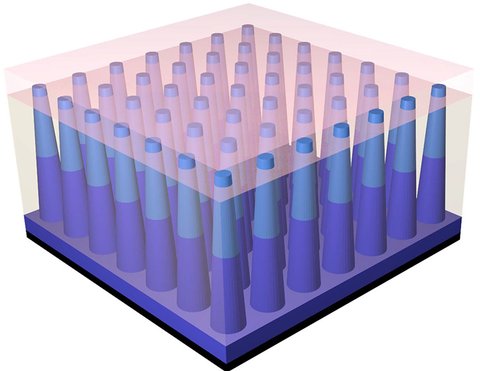16 October 2016
Researchers at TU Eindhoven have gained a new world record for the efficiency of nanowire-based solar cells: 17.8 percent. These types of solar cell have been around for just a few years but in terms of efficiency are catching up to other types and are thus very promising for the sustainable energy supply. TU/e researcher Dick van Dam will be awarded his doctorate on 17 October for his research that makes this possible.
In contrast to other types of solar cell, nanowire solar cells are not composed of solid, flat layers. They comprise a ‘lawn’ of vertical wires of around two hundred nanometers thick, or 300 times thinner than a human hair. These nanowires capture the light and convert it into electricity. Since their discovery less than a decade ago, their efficiency has risen to 17.8 percent, an increase that other types of solar cell took forty years to achieve.
The previous record, of 15.3 percent, was held by Sweden’s Lund University. The efficiency percentage indicates how much of the sunlight that falls on the cell can be used as electrical energy. Theoretically, the limit for nanowire solar cells is 46 percent, considerably higher than that for flat, layered solar cells at 34 percent. In addition, nanowire cells are quite cheap to produce by comparison.
So there is still a lot of room for improvement. Van Dam hopes that his record falls quickly; he reckons that twenty percent is on the cards within the next few years. But if the nanowire cells are to become commercially viable, they need to be price competitive. And to be that, a yield of around 25 percent is needed along with an improved production process. In terms of costs, big gains can be made by switching from the relatively rare material indium phosphide to the much more abundant semiconductor silicon.
Producing the world’s most efficient nanowire cell is partially the result of the theoretical and experimental work of Dick van Dam. His fellow researcher Yingchao Cui manufactured the solar cell in the cleanroom of TU/e. Van Dam discovered in his research that the nanowire cell absorbed up to twenty percent more light because the wires acted as a kind of antenna to capture the light. Additionally, they are using five times less material than flat solar cells. That has benefits since less material means lower risk of errors in the material that can cause a reduced energy yield. Another factor that contributes to the performance of the nanowire cell is that the wires concentrate the light. Van Dam’s research has revealed that the diameter of the nanowires determines how well the light can be concentrated.
Dick van Dam receives his PhD on 17 October in the Photonics and Semiconductor Nanophysics group of the Applied Physics department. In 2012 he was the series winner of the TV quiz ‘Met het mes op tafel’, a kind of mix of poker and knowledge.















